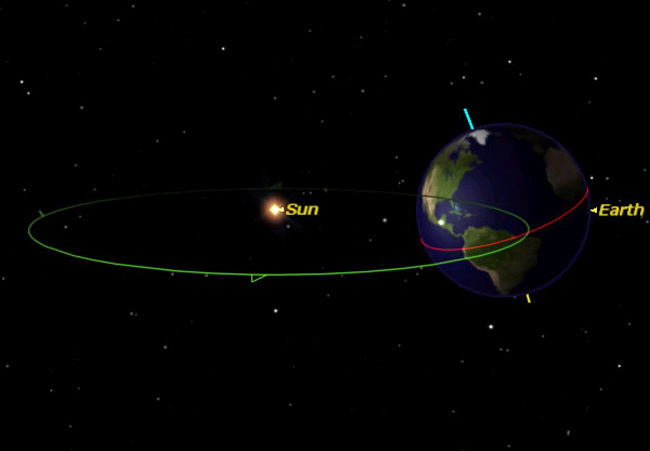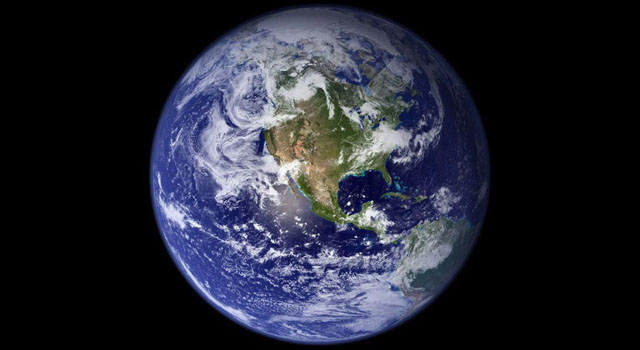
Dads everywhere will celebrate Father's Day today (June 21), and the Earth is joining the fun this year with the summer solstice, kicking off the first day of the northern summer.
At 12:38 p.m. EDT today (1638 GMT), the sun will reach that point where it will appear to shine farthest to the north of the equator, over the Tropic of Cancer, thus marking the summer solstice. The height of the midday sun has been getting progressively higher since Dec. 21 (the winter solstice), as its direct rays have been gradually migrating to the north.
The sun's height above the horizon at noontime is 47 degrees higher now, compared to six months ago. (As always, your clenched fist held at arm's length covers about 10 degrees of the sky. At midday, the sun will now appear nearly "five fists" higher in the southern sky as compared to Dec. 21st.) [Solar Quiz: Do You Know Our Sun?]
A "solstice" is a staying of the sun's apparent motion over the latitudes of the Earth. In the summer solstice, the sun stops its northward motion and begins heading south. During the winter solstice, the sun does the opposite, turning north. In the Southern Hemisphere, today marks the start of winter.
At one minute past the summer solstice (by 12:39 p.m. EDT), the sun will have already begun its southward migration back across the sky. The sun will cross the equator at the autumnal equinox, passing into the Southern Hemisphere, on Sep. 23, at 4:21 a.m. EDT (0821 GMT).
From temperate latitudes, the sun never appears directly overhead.
Today in Lewiston, Maine, for instance, as the sun crosses the meridian at 12:42 p.m. EDT, it will attain its highest point in the sky for this entire year, standing 70 degrees above the southern horizon. Since the sun will appear to describe such a high arc across the sky, the duration of daylight is now at its most extreme, lasting 15 hours and 29 minutes for Lewiston.
Get the Space.com Newsletter
Breaking space news, the latest updates on rocket launches, skywatching events and more!

Daylight lasts longer are more northerly latitudes; less at more southerly latitudes. North of the Arctic Circle, for instance, the sun now remains above the horizon 24/7 (providing the so-called "midnight sun" effect). On the other hand, at the equator days and nights are equal, lasting 12 hours (a circumstance there that lasts all year long).
Surprisingly, the earliest sunrise and latest sunset do not coincide with the summer solstice. In fact, at mid-northern latitudes, the earliest sunrise actually happened on June 14, while the latest sunset won't occur until June 27.
So if you're celebrating Father's Day with dad today, be sure to wish him a very Happy Summer Solstice, too!
Joe Rao serves as an instructor and guest lecturer at New York's Hayden Planetarium. He writes about astronomy for Natural History magazine, the Farmer's Almanac and other publications, and he is also an on-camera meteorologist for News 12 Westchester, N.Y. Follow us @Spacedotcom, Facebook and Google+. Original article on Space.com.
Join our Space Forums to keep talking space on the latest missions, night sky and more! And if you have a news tip, correction or comment, let us know at: community@space.com.

Joe Rao is Space.com's skywatching columnist, as well as a veteran meteorologist and eclipse chaser who also serves as an instructor and guest lecturer at New York's Hayden Planetarium. He writes about astronomy for Natural History magazine, Sky & Telescope and other publications. Joe is an 8-time Emmy-nominated meteorologist who served the Putnam Valley region of New York for over 21 years. You can find him on Twitter and YouTube tracking lunar and solar eclipses, meteor showers and more. To find out Joe's latest project, visit him on Twitter.









